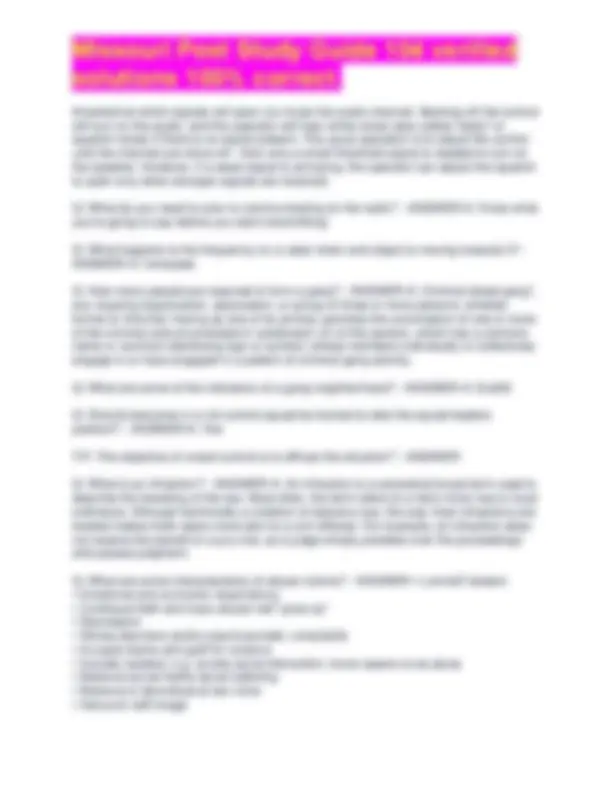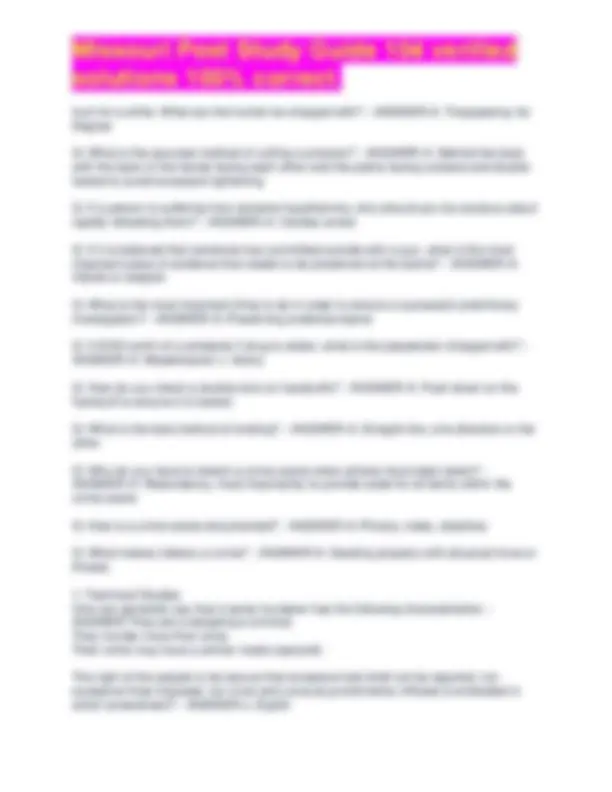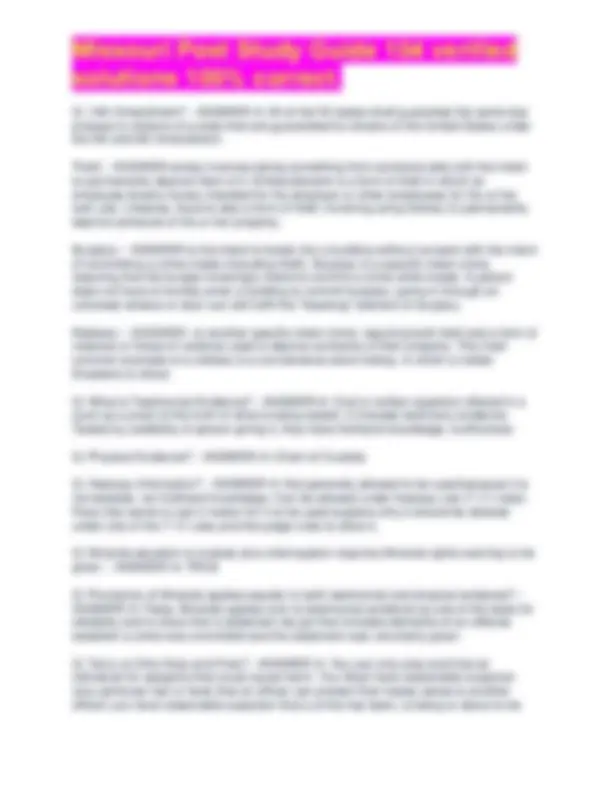









Study with the several resources on Docsity

Earn points by helping other students or get them with a premium plan


Prepare for your exams
Study with the several resources on Docsity

Earn points to download
Earn points by helping other students or get them with a premium plan
Community
Ask the community for help and clear up your study doubts
Discover the best universities in your country according to Docsity users
Free resources
Download our free guides on studying techniques, anxiety management strategies, and thesis advice from Docsity tutors
Missouri Post Study Guide 104 verified solutions 100% correct. Missouri Post Study Guide 104 verified solutions 100% correct. Missouri Post Study Guide 104 verified solutions 100% correct. Missouri Post Study Guide 104 verified solutions 100% correct. Missouri Post Study Guide 104 verified solutions 100% correct. Missouri Post Study Guide 104 verified solutions 100% correct. Missouri Post Study Guide 104 verified solutions 100% correct. Missouri Post Study Guide 104 verified solutions 100% correct. Missouri Post Study Guide 104 verified solutions 100% correct. Missouri Post Study Guide 104 verified solutions 100% correct. Missouri Post Study Guide 104 verified solutions 100% correct.
Typology: Exams
1 / 13

This page cannot be seen from the preview
Don't miss anything!








Q: Do all ATV accidents have to be reported in Statewide Traffic Accident Records System (STARS)? - ANSWER-A: No. However, every law enforcement officer who investigates a vehicle accident resulting in injury to or death of a person, or total property damage to an apparent extent of "five hundred dollars" or more to one person, or who otherwise prepares a written report as a result of an investigation. Q: What is the preferred method of measurement in a traffic accident? - ANSWER-A: Triangulation - triangulation is the process of determining the location of a point by measuring angles to it from known points at either end of a fixed baseline, rather than measuring distances to the point directly (trilateration). The point can then be fixed as the third point of a triangle with one known side and two known angles. Q: How many types of fingerprints are there? - ANSWER-A: There are three main fingerprint patterns: Arches, Loops and Whorls. Q: Who should advise juveniles of their rights? - ANSWER-A: Juvenile Officer. Q: Who can transport juveniles? - ANSWER-A: Officers can transport juveniles to a juvenile detention facility or to a medical facility for treatment when necessary. Q: What do you write in a block that is not used in a STARRS report? - ANSWER-A: If the question asked does not apply, mark the "NA" box when available or neatly enter "NA" (Not Applicable) in the section. If the information is not known, enter "Unknown". EVERY FIELD MUST HAVE A RESPONSE. Q: How is the date/time written in a STARS report (ex. MM-DD-YYY)? - ANSWER-A: Example: January 3, 2000 should be shown as 01- 03 - 2000. Use Military time (24 hr clock) when recording time on a STARS Q: Who should you be cautious with, when conducting a traffic stop?(everyone) - ANSWER-A: Everyone - you must maintain situational awareness at all times of the driver, any passengers, traffic, and what you cannot see (i.e. hidden compartments such as the trunk). Q: What are the two firing stances for the pistol? - ANSWER-A: The Isosceles and the Weaver. Q: Is the year of the vehicle indicated in the VIN? - ANSWER-A: Yes
Q: Can the VIN be located on the dashboard of a vehicle? - ANSWER-A: Enter Vehicle Identification Number (VIN) as shown on vehicle. Normally, the VIN on cars and trucks is located on the left front dashboard adjacent to the windshield (Driver Side). Q: What three types of driving are conducted in a law enforcement vehicle? - ANSWER- A: Emergency, non-emergency, and pursuit Q: When operating a vehicle in a non-emergency status, what traffic laws must be followed? - ANSWER-A: Vehicles shall comply with all of the traffic laws and rules of the road that apply to all other vehicles. Q: What should you not do for someone suffering from heat stroke? - ANSWER-A: Ice Blanket, do not give them food or water. While waiting for the paramedics to arrive, initiate first aid. Move the person to an air-conditioned environment -- or at least a cool, shady area -- and remove any unnecessary clothing. If possible, take the person's core body temperature and initiate first aid to cool it to 101 to 102 degrees Fahrenheit. If no thermometers are available, don't hesitate to initiate first aid. You may also try these cooling strategies:
hunt for a while. What can the hunter be charged with? - ANSWER-A: Trespassing 1st Degree Q: What is the securest method of cuffing a prisoner? - ANSWER-A: Behind the back with the back of the hands facing each other and the palms facing outward and double locked to avoid excessive tightening Q: If a person is suffering from extreme hypothermia, why should you be cautious about rapidly reheating them? - ANSWER-A: Cardiac arrest Q: If it is believed that someone has committed suicide with a gun, what is the most important piece of evidence that needs to be preserved at the scene? - ANSWER-A: Hands or weapon Q: What is the most important thing to do in order to ensure a successful preliminary investigation? - ANSWER-A: Preserving evidence/scene Q: If $100 worth of a schedule II drug is stolen, what is the perpetrator charged with? - ANSWER-A: Misdemeanor v. felony Q: How do you check a double-lock on handcuffs? - ANSWER-A: Push down on the handcuff to ensure it is locked. Q: What is the best method of braking? - ANSWER-A: Straight line, one direction or the other Q: Why do you have to sketch a crime scene when photos have been taken? - ANSWER-A: Redundancy, most importantly to provide scale for all items within the crime scene Q: How is a crime scene documented? - ANSWER-A: Photos, video, sketches Q: What makes robbery a crime? - ANSWER-A: Stealing property with physical force or threats
Q: 14th Amendment? - ANSWER-A: All of the 50 states shall guarantee the same due process to citizens of a state that are guaranteed to citizens of the United States under the 5th and 6th Amendment. Theft: - ANSWER-simply involves taking something from someone else with the intent to permanently deprive them of it. Embezzlement is a form of theft in which an employee diverts money intended for his employer or other employees for his or her own use. Likewise, fraud is also a form of theft, involving using trickery to permanently deprive someone of his or her property. Burglary: - ANSWER-is the intent to break into a building without consent with the intent of committing a crime inside (including theft). Burglary is a specific intent crime, requiring that the burglar knowingly intend to commit a crime while inside. A person does not have to forcibly enter a building to commit burglary; going in through an unlocked window or door can still fulfill the "breaking" element of burglary. Robbery: - ANSWER-: is another specific intent crime, requiring both theft and a form of violence or threat of violence used to deprive someone of their property. The most common example of a robbery is a convenience store holdup, in which a robber threatens to shoot. Q: What is Testimonial Evidence? - ANSWER-A: Oral or written assertion offered in a court as a proof of the truth of what is being stated. It includes testimony evidence. Tested by credibility of person giving it, they have firsthand knowledge, truthfulness Q: Physical Evidence? - ANSWER-A: Chain of Custody Q: Hearsay information? - ANSWER-A: Not generally allowed to be used because it is not testable, not firsthand knowledge. Can be allowed under hearsay rule (7-11 rules). Party that wants to use it motion for it to be used explains why it should be allowed under one of the 7-11 rules and the judge rules to allow it. Q: Miranda equation is custody plus interrogation requires Miranda rights warning to be given. - ANSWER-A: TRUE Q: Provisions of Miranda applies equally to both testimonial and physical evidence? - ANSWER-A: False. Miranda applies only to testimonial evidence as one of the tests for reliability and to show that a statement we got that includes elements of an offense establish a crime was committed and the statement was voluntarily given. Q: Terry vs Ohio Stop and Frisk? - ANSWER-A: You can only stop and frisk an individual for weapons that could cause harm. You Must have reasonable suspicion (any particular fact or facts that an officer can present that makes sense to another officer) you have reasonable suspicion that a crime has been, is being or about to be
Q: You are asking guild seeking questions, you haven't used any physical force, and you've only currently just asked for the conversation to take place. The suspect is nervous and suspect believes he or she cannot leave or that he or she can refuse to answer do Miranda rights be given? - ANSWER-A: TRUE. Because it is what the suspect believes "cannot leave and can refuse to answer" that matters for Miranda issues. Q: There are two general requirements for a person to be found criminally reliable. - ANSWER-A: 1. Persons conduct must be a voluntary act. 2. Culpable mental state. Tennessee vs Garner obligated by 4th amendment to give warning to use deadly force "if feasible". MO Statutory law defines four instances in which you may use force to include deadly force by statute A Missouri officer has a criminal defense if you reasonable believe it is immediately necessary to use deadly force and:
Q: Statutory difference in Missouri between Forcible Rape and Sexual Assault? - ANSWER-A: Forcible rape: threat, force used, drugs used, taking advantage of a mentally incompetent person Sexual assault: Lack of consent **In Missouri, Any sexual intercourse with any person under the age of 14 it is automatically Statutory Rape in the first degree by virtue of the persons age. Q: The only time possession of a controlled substance is a misdemeanor defense is? - ANSWER-A: The amount of Marijuana, K2 or Spice possessed is less than 35 grams. If you give or sell to someone else it is a Felony. Schedule I Drugs - ANSWER-High potential for abuse or misuse and has no current accepted medical use (METH, Heroin, LSD, Marijuana) Schedule II Drugs - ANSWER-The drug or other substances have a high potential for abuse, the drug or other substances have currently accepted medical use in treatment in the United States, or currently accepted medical use with severe restrictions, Abuse of the drug or other substances may lead to severe psychological or physical dependence. (OxyCotin, Percecet, Fentanyl, Morphine) Schedule III Drugs - ANSWER-The drug or other substance has a potential for abuse less than the drugs or other substances in schedules I and II, The drug or other substance has a currently accepted medical use in treatment in the United States, Abuse of the drug or other substance may lead to moderate or low physical dependence or high psychological dependence. (Steroids, Barbituates, Vicodine, PCP) Schedule IV Drugs - ANSWER-The drug or other substance has a low potential for abuse relative to the drugs or other substances in schedule III, The drug or other substance has a currently accepted medical use in treatment in the United States, Abuse of the drug or other substance may lead to limited physical dependence or psychological dependence relative to the drugs or other substances in schedule III. (Xanax, Valium, Ambien, Provigil) Schedule V Drugs - ANSWER-The drug or other substance has a low potential for abuse relative to the drugs or other substances in schedule IV, The drug or other substance has a currently accepted medical use in treatment in the United States, Abuse of the drug or other substance may lead to limited physical dependence or psychological dependence relative to the drugs or other substances in schedule IV. (Cough Supressants, Weight loss drugs, Atrophine, Diphenoxylate) Q: Driving while intoxicated (DWI) requires the drive to have .05% BAC? - ANSWER-A: FALSE. There is no amount of BAC in the state of Missouri that is required to file charges to prove DWI. BAC has no influence. Impaired driving is the basis for DWI.
assault. Punishments under Class A Misdemeanors include a penalty up to one year in a county jail that may include a fine up to one thousand dollars Class B Misdemeanors - ANSWER-have penalty punishments of up to six months or as low as thirty days in a county jail facility with or without a fine up to five hundred dollars. Class B Misdemeanors can include a first offense of driving while intoxicated, a first offense of driving under the influence, and first-degree trespassing. Class C Misdemeanor - ANSWER-This category in punishable by up to fifteen days in a county jail with or without a fine up to three hundred dollars. Class C Misdemeanors include the first offense of driving with excessive blood alcohol content.